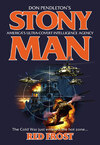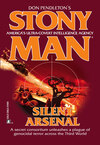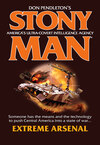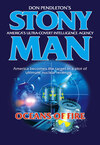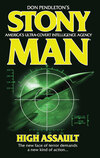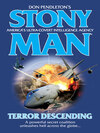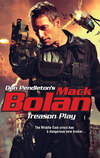Читать книгу: «Red Frost», страница 3
CHAPTER TWO
Stony Man Farm, Virginia,
9:49 a.m. EDT
Fourteen minutes after the Russian sub ran aground on Ediz Hook, eight minutes after receiving a frantic hot-line call from the White House, five minutes after Jack Grimaldi was notified of the situation via secure scrambled channel, Hal Brognola was still staring at the satellite feed replay on the flat-panel wallscreen. He couldn’t help himself. The other members of the Stony Man team—mission controller Barbara Price, weapons specialist John “Cowboy” Kissinger, and the elite cyber squad of Aaron “the Bear” Kurtzman, Huntington Wethers, Akira Tokaido and Carmen Delahunt—were all having the same reaction.
Recurring disbelief.
The image on the screen was that shocking.
The bow of the huge black foreign warship jutted out of U.S. waters, its submerged propeller churning up plumes of froth. In the background, not one hundred yards away, stood the little orange Coast Guard air station hangar at the tip of Ediz Hook.
A second flat-panel wallscreen was filled with jerky live-feed video with sound from a circling Coast Guard helicopter. A dense pillar of smoke boiled up from the sub’s sail, drifting lazily south over the little mill town.
Brognola knew that at that moment additional Coast Guard and Navy helicopters from Neah Bay and Whidbey Island, respectively, were en route, as was the emergency-nuclear-response unit from sub base Bangor on Hood Canal. ETA on the ENR team was five more minutes. Meanwhile, scrambled A-6s from Whidbey Naval Air Station were already screaming low over the scene, sealing off the airspace.
As the Coast Guard video zoomed in tight on the sub’s stern and the churning prop, the head Fed couldn’t help but grimace. Nuke-powered boat running full tilt half out of the water, smoke pouring out amidships. Brognola wasn’t the only one who visualized dire consequences.
“For pete’s sake, why doesn’t the crew shut down the engines!” Barbara Price exclaimed.
“It’s got to be hotter than hell in there,” Hunt Wethers said. The African American, former Berkeley cybernetics professor gestured at the screen with the mouthpiece of his unlit pipe and said, “Why hasn’t anyone bailed from the sub?”
“Maybe they can’t get out,” Akira Tokaido suggested. “Exit routes all blocked…”
“Actually, the damage doesn’t look that bad,” Kissinger told the young Japanese American. “Like a lot of the Russian subs, the hull is probably made up of two layers, an inner and outer skin with six feet of crush space between them, so even grounded there might not be a full breach. I’ve never seen that design configuration before, but the ship is similar to the Bars class attack subs—something just over three hundred feet in length. There’s got to be at least thirty or forty crew on board.”
“Is it carrying nukes?” Delahunt asked. The redheaded former FBI agent and divorced mother of three put her finger right on the hot button.
“It’s an SSN, not a ballistic-missile sub,” Kissinger said, “but who knows what armament’s on board.”
“There’s a nuclear reactor, though,” Brognola countered.
“Actually there are probably two pressurized water reactors,” Kissinger corrected him.
“They are the critical issue at this point,” Brognola said. “Something’s already burning inside.”
Kissinger immediately picked up the thread. “If sub’s reactors catch fire,” he said, “their nuclear material will be released into the surrounding air and water. If there are nukes onboard, they won’t detonate from the heat, but their payloads will be dispersed.”
Aaron Kurtzman pivoted his wheelchair to face the others. “With strong tides running all the way to Seattle and Tacoma,” he said gravely, “the scale of the disaster would be unthinkable.”
“And for all intents and purposes, irreparable,” Wethers added.
The last comment was met by silence.
“The ENR unit is going to have to work quickly,” Kissinger said. “They’ve got to get inside the ship, put out the fires and shut down propulsion. After that, they can start a full damage assessment, structural and nuclear. If it turns out the sub can be safely towed off the point, they have to identify and secure all hull breaches by sealing internal bulkhead doors.”
“Do you think they’ll meet resistance from the crew?” Price asked.
“A separate SEAL team will deal with that,” Brognola answered for him. “They’ll handle the initial boarding and pacification, if necessary.”
The scene on the live-feed video suddenly shifted as the Coast Guard chopper wheeled to the north, flying around the edge of the smoke plume. The Hook’s narrow road curved past the Daishowa pulp mill before joining up with the mainland at the head of the bay. Five Port Angeles police cars were parked across the two-lane road with lights flashing. On the far side of the cruisers, the town’s entire complement of fire engines and ambulances sat idling, waiting for an all-clear so they could approach the stranded ship.
Traffic had already started to back up on the road behind the EMTs. It wasn’t just night-shift mill hands who’d deserted their posts for a look, or morning-shift workers waiting around for their day to begin. The resounding impact of the sub’s grounding had awakened most of the city’s population. From virtually every street corner on the hillsides above the bay, if not every kitchen window, the black ship was a visible blot on the landscape. In response, whole families had piled into their cars and vans, heading for the Hook in hopes of getting a closer view of the spectacular accident. As a result, the streets of Port Angeles’s tiny downtown were gridlocked, bumper to bumper. The smarter folks, the few who could distinguish imminent danger from free circus, were already streaming out of town in the other direction, on Highway 101.
The Coast Guard helicopter veered to the left and swung out over Port Angeles Bay. Its video feed revealed an armada of small and large boats racing from the mainland shore, all making a beeline for the Hook and the object of curiosity. The chopper pilot flew low and fast on an intercept course.
Stony Man’s wallscreen filled with a bird’s-eye view of the sixteen-foot runabout leading the pack. Its lone passenger was hanging on to the windshield with one hand, trying to use a digital camcorder with the other. Rotor wash whipped a ring of froth around the little boat, forcing the photographer to sit down. It blinded the boat’s pilot, and he backed off on the throttle.
Someone in the hovering aircraft, presumably the pilot or copilot, addressed the oncoming fleet through a loud-hailer. “Return to the harbor at once! For your own safety, return to shore! This is a restricted area!”
A few of the boaters immediately turned back; however, most ignored the command. There was obviously no way to enforce it. There were too many boats and the helicopter was unarmed.
“Where’s Homeland Security?” Delahunt said.
“Basically, you’re looking at it,” Kissinger replied. “There’s a Coast Guard cutter on station out at the entrance to the Strait of Juan de Fuca. But that’s almost two hours away. A handful of part-time DHS personnel man the international border where the ferry from Canada docks.”
“No way anyone could have foreseen something like this,” Brognola said emphatically. “This should never have happened.”
“Okay, John,” Price said, turning to the Farm’s weapon systems analyst, “give us your best guess. How is what we’re looking at even possible?”
“The U.S. antisubmarine—ASW—warfare program consists of layered defenses using different technologies,” Kissinger said. “Some of them are cold war era, some more recent. There’s SURTASS, surveillance towed array system. RDSS, rapidly deployable surveillance system. LRMP, long-range marine patrol, armed with magnetic-anomaly detectors. There’s radar and stationary directional and nondirectional sonar buoys. A more recent development is UDAR, a satellite-mounted laser aimed at the sea. It reflects off and reveals a submerged sub’s wake.”
“Sounds pretty solid to me,” Delahunt said.
“Yeah, but you’ve got to keep in mind that the surveillance is covering a vast area above and below the surface. For decades, our ASW people have been monitoring the sub bases in the Sea of Okhotsk, the Barents Sea, the Kola Peninsula and Gremikha. At these choke points, Russian subs can be identified and tracked by satellite and by U.S. sub patrols on station. Past the choke points, in the open ocean, the technological net has holes.”
“What do you mean by ‘holes’?” Tokaido asked.
“There’s an overlap of radar bounce-back, called a shadow or convergence zone, that creates a blind channel thirty-three nautical miles wide. Subs can hide in it and evade detection. The Russians have perfected the welding of titanium for their sub hulls, which makes them harder to locate through magnetic anomaly. Some of their ships can make forty-two knots submerged to three thousand feet.”
“Our ships are fast, too, and our people are absolutely top notch,” Price countered. “In fact, there’s no comparison.”
“No argument there,” Kissinger said. “Equipment and personnel aren’t the problem. It’s mission creep. Between the end of the cold war and the start of the second Iraq war, our fleet’s patrol duties were reevaluated and redefined. The hostile threat from Russia was downgraded, and some of our subs were taken off SSBN patrol and converted into platforms for launching conventionally armed missiles against military targets in the Near East. Fewer patrols means bigger holes.”
“Sorry, it still doesn’t compute,” Kurtzman said. “Harder to detect isn’t the same as undetectable.”
“I can’t explain why UDAR and resonance scatter didn’t pick up that ship well out to sea,” Kissinger said. “At this point there’s not enough data to know what happened. After Able Team arrives on scene we’ll have more to work with.”
“Their ETA isn’t until 9:15 a.m., PDT,” Brognola said. “We can’t just sit here and twiddle our thumbs. From what the President told me, the Russians are denying all knowledge of the sub or the nature of the incursion. They are denying it’s even their ship.”
The chief of the cyberunit spoke up. “Hunt and Carmen, let’s search the DOD’s secure database and try to ID the ship from the hull configuration. Pull up everything about sub designers and shipyards. I’ll check the satellite surveillance library and backtrack all departures from the known SSBN and SSN bases. Maybe we can figure out where this sub came from and when it left its home port.”
“We don’t know its route after it entered the Strait of Juan de Fuca, either,” Tokaido said. “I’ll go over the sat-feed system replays, second by second. That might tell us something about the sub’s mission.”
“Did the President make it clear why he was calling in Able Team on this?” Price asked Brognola.
“He wants all means at his disposal.”
“Able can do things the white ops can’t,” Wethers said.
“Like shoot reporters?” Delahunt joked.
“Too many talking heads, not enough bullets,” Kissinger said.
“John’s right,” Kurtzman said. “This is going to be a three-ring circus. You can bet news helicopters from Seattle are already en route. There’s no way to stop the media even if the Navy seals off the airspace. You can see that wreck from Vancouver Island in Canada, twenty-six miles away.”
“Able’s mission isn’t a cover-up,” Brognola told his people. “The President wants someone on the ground who can cut through the bullshit. He anticipates problems with overlapping responsibilities in this crisis.”
“Turf wars between Homeland Security, FBI, CIA, Navy, Coast Guard and state and local police?” Delahunt asked.
“You got it,” Brognola said.
“Under the circumstances, Able Team is bound to step on some toes,” Kurtzman said. “And they never step lightly.”
“The President doesn’t care about that. He wants the job done fast, and he wants it done right.”
Tokaido pointed at the wallscreen. “Here come the good guys,” he said.
Live-feed video showed four Navy helicopters descending on the Hook in tight formation. As soon as their wheels touched the Coast Guard air station’s landing pad, men in black jumped from the bay doors.
They hit the ground running.
CHAPTER THREE
Port Angeles, Washington,
7:02 a.m. PDT
As Commander Reuben Starkey and his ENR crew hurriedly off-loaded gear from their helicopter onto a pair of handcarts, the thirty-two-man SEAL team closed on the grounded sub with autoweapons up and ready. Half of the commando unit took up bracketing-fire positions along the Hook’s riprap, the rest leapfrogging each other to the underside of the looming black bow.
A tight, excited voice crackled in Starkey’s communication headset. It was the SEAL team leader, Captain Bradford Munsinger. “ENR, we’ve got severe crush damage forward,” he reported. “Background rads are within acceptable limits. We’re going up.”
Commander Starkey and his four subordinates stopped shifting equipment; they turned and watched the SEALs in rapt silence. Like Starkey, the others were all career Navy men. In the seven years they had worked together at sub base Bangor, they had handled various highly classified and potentially catastrophic nuclear emergencies in Puget Sound, along the western seaboard and in the Pacific theater. Despite that experience and expertise, Starkey found himself cotton-mouthed by what lay before them this morning.
Spitless.
As far as Starkey was concerned, the unheard-of incursion into U.S. territorial waters and breach of national defense systems took a backseat to more immediate and pressing problems. A little slice of America, the Olympic Peninsula mill town, stood utterly defenseless behind them. The nuke-powered vessel was on the beach and on fire. There was no way of telling what kinds of armament the ship was carrying. The commander could feel the vibrations of the rampaging engines and prop through the airstrip’s tarmac, even though the submarine was three hundred yards away.
Stepping out from under the protection of the hull, the SEALs took turns firing grappling hooks onto the deck, more than four stories above them. With the sub’s sail and escape-trunk hatches zeroed in by flanking fire, black-gloved men shouldered automatic weapons and scrambled up the knotted ropes. The first SEAL to land boot soles on the steeply slanted deck was Bradford Munsinger. Following his hand signals, the others covered the forward and aft escape hatches point-blank with their 9 mm H&K machine pistols.
“Radiation is still within acceptable limits,” Munsinger announced into his mike. “Come on up, boys, and join the party.”
ENR stayed put. He wasn’t talking to them.
Starkey and his crew watched the commandos under the bow start shinnying up the ropes. As they did so, Munsinger mounted the sail’s exterior ladder with two SEALs following hard behind him. After a rapid ascent, the trio disappeared over the rim of the bridge into the uncoiling black smoke.
A moment later the captain said, “ENR, we have position and control. The bridge hatch is closed.”
A head and shoulders appeared above the sail on the windward side, a tiny pimple on the enormous silhouette.
“The view from up here’s nice, but the air quality sucks,” Munsinger joked, his voice breaking, his breathing hard and ragged.
The man standing next to Starkey shielded his mike with his hand and said, “Cap sounds like he’s been huffing helium.” Dave Alvarez was a tall, lanky, fish-white nuclear engineer, and he spoke with a heavy New Jersey accent.
“Munsinger’s way pumped,” Chuck Howe agreed, turning his head to spit a gob of brown tobacco juice onto the tarmac.
“I know just how he feels,” Alvarez said. “That sound you hear isn’t castanets. It’s my knees knocking.”
“The smoke seems to be coming through vents in the deck plating up here,” Munsinger continued after a pause. “The sail’s hull is hot to the touch. Still no substantial radiation.”
“Initial rescue procedures are a go, then,” Starkey said into his mike.
“Roger that, ENR,” Munsinger said.
Then he addressed his men. “Okay, SEALs, let’s say howdy to these lost sons of bitches.”
The clang of gun butts on titanium plating was drowned out by the dull, sawing roar of the engines and the pounding of the three-story-high prop. SEALs crawled over the exposed deck with listening devices, monitoring any response from the sub’s crew.
The reports rattled back, all in the negative.
“What the fuck is going on!” Garwood Shambliss exclaimed.
Starkey shook his head at the black diver and pointed at the open mike under his blocklike chin, reminding him about the open channel. Shambliss could have been a SEAL himself; he was built lean and hard like one, he had the athletic skills, but his interest was in warships, not in the hands-on waging of war.
Shambliss smothered the mike in his big, scarred fist. “What…the…fuck!” he repeated, carefully enunciating each word. “Trapped inside a burning ship and nobody answers a rescue call? There should be forty sailors on that boat, minimum. And there’s nobody at the helm?”
“Commander, have we got a nuclear ghost ship on our hands?” Pete Deal asked.
Starkey said, “That makes no sense, Pete.” It wasn’t the only thing that didn’t make sense to him. The sub on the Hook didn’t conform to the established Russian fleet standards. It was clearly a design variant, an undisclosed variant, in direct violation of a long-standing treaty.
“Maybe they’re embarrassed,” Alvarez suggested. “They just beached a one-hundred-million-dollar boat on foreign soil.”
“Where the hell is HazMat?” Shambliss said, looking at the sky to the southeast. There were no aircraft in sight.
“They’ve got more gear and people to deal with,” Starkey said. Based in Bremerton, the Navy’s regional HazMat unit transported an entire mobile field hospital, operating rooms, decontamination equipment, isolation chambers, mortuary and personnel to handle catastrophic medical emergencies. Washington’s only civilian HazMat unit was part of the state patrol and stationed in Tacoma, 150 miles away.
Munsinger’s excited voice crackled in their headsets. “I’m going to try the bridge hatch,” he announced.
A second later a puff of much thicker smoke erupted from the sail, like a wet blanket lifted from a ridgetop signal fire.
“The hatch wasn’t dogged from the inside,” the captain reported. “We’ve got clear access.”
“SEAL leader, this is ENR,” Starkey barked into his mike. “Do not enter subject vessel. Repeat, do not attempt to enter the vessel. Close the hatch and pull back, get out of the smoke if you possibly can. We’re on our way.”
To his crew, he said, “Break out the Nomex….”
With or without HazMat, they had a job to do.
Shambliss, Deal, Howe and Alvarez ripped into the ballistic nylon duffels and started yanking out gear on the double. Commander Starkey did the same. He kicked off his shoes and slipped stocking feet into the legs of his fire suit. He stepped into the attached lug boots, rammed his arms through the sleeves, then zipped up the front closure to his chin. After pulling the drawstring hood tight around his weather-seamed face and unshaved cheeks, he donned a super-high-intensity headlamp. He hung the full-face air mask from the Nomex suit’s left shoulder tab and, after checking the pressure gauge, strapped the attached miniair tank to his left hip. The suit’s heavy gauntlets, also fire-retardant Nomex, were securely Velcroed to the insides of the sleeves.
In their fire armor, the team finished transferring the backpack extinguishers, the cases of electronic gear and hand- and battery-operated power tools to the carts. The much more restrictive antiradiation suits were loaded on, too, in case things suddenly went even further south. With five strong men pushing, the heavily laden hand trucks moved easily along the runway. When they reached the end of the asphalt and the wheels bumped onto the loose gravel path that led to the end of the Hook, the going got difficult. Three SEALs shouldered their weapons and ran over to give them a hand. With four to a cart, they were able to half carry the trucks and gear.
“Looks like the smoke’s starting to get thinner,” Alvarez said as they neared the sub’s bow. His lean face bulged from the pressure of the tight-fitting Nomex hood. “Maybe the crew put it out or it burned itself out.”
When no one responded to the speculation, he took the hint and kept quiet. It was nervous talk. And pointless. Whatever was happening inside, they were going to be in the middle of it shortly.
When they were in the lee of the ship, the enormous raised black bow blocked out most of the sky. Crush damage to the forward keel was considerable. It was impossible to tell whether the interior hull had been damaged. As they stepped up beside the hull, the ground trembled underfoot.
Reuben Starkey had learned Russian at the military language school in Monterrey, California. He had visited the Severodvinsk shipyard as an official observer, and had guzzled vodka with Russian submariners, designers and builders. As the ENR’s expert in Russian technology, he knew what had to be on board, and what might be on board. His wife, Sandy, and their three kids were in Silverdale, one hundred miles away, on the far side of the Olympics and the Hood Canal. Whatever happened here, even if it was thermonuclear, they would be safe. He took comfort from that, and he was thankful he’d made the time to kiss them all and say goodbye.
The SEALs on deck deployed rope ladders, and Starkey and the others began to climb them. Commandos on the ground hooked up other dangling lines to the assortment of ENR gear, and the men above hoisted it up, hand over hand.
The deck angle seemed even steeper when Starkey was actually standing on it. SEALs had already rigged safety cables to the sail. The vibration was tremendous, as was the noise. Starkey found it disorienting to look downward aft and see the wash deck half-submerged.
He tore his gaze from the white water roaring behind. He proceeded with one hand on the safety line to the sail’s fixed ladder, then started up. The Coast Guard helicopter hovered above him at about one thousand feet. As he swung a leg over the sail’s rim, he looked back, across the air strip at the cop cars and fire trucks. Seven stories high, he could see the camera flashes going off along the line of backed-up civilian traffic. Rubbernecking idiots, he thought.
The smoke had definitely thinned out some by the time Starkey hopped down to the bridge deck. He wasn’t just sweating inside the fire suit. He was lubed, head to foot.
Munsinger’s round, tanned face was speckled with soot; it was on his teeth when he smiled and nodded a greeting. In a gloved hand he held his machine pistol pointed in the air, the ejector port resting against his meaty shoulder. Two other SEALs stood on the bridge like statues, aiming their stubby weapons at the closed hatch.
“Still no response?” Starkey asked into the mike so he could be heard over the ambient roar. The smoke had a definite electrical tang to it.
Munsinger shook his head and said, “Maybe they’re playing possum.”
One by one, in rapid order, the other ENR guys piled over the sail’s rim. Then Starkey ordered lines dropped to the wash deck so they could haul up their dry chemical fire extinguishers and other gear. With five of them pulling, it took no more than three minutes to raise the cylinders and gear bags to the bridge. When Starkey put on his air mask, the rest of his team followed suit. They turned on their compressed-air tanks, switched on the headlamps and pulled on gauntlets. That done, they helped one another shrug into the straps of the backpack fire extinguishers. They then armed one another’s extinguishers by pulling the safety pins and cranking down the levers that punctured the CO2 propellant cartridges.
“Open it,” Starkey told the SEALs.
When the hatch cover fell back to the deck, it released another puff of smoke, only much less black. With the hatch open, a warning klaxon could be heard belowdecks, its shrill pulsation barely audible over the engine and prop roar. The SEALs retreated a yard or so, still covering the entrance.
As the smoke continued to rise, Starkey lifted his mask, leaned over the hatch and shouted down in Russian through a cupped hand, “You are about to be boarded by the U.S. Navy. This is a rescue operation. Do not resist. We’re here to help you.”
If anybody heard him, they didn’t answer.
If anybody answered, he didn’t hear them.
As Starkey straightened, Howe passed him the hand-held NIFTI—navy infrared thermal imager—and power pack.
“We sweep before you go down,” Munsinger said as he stepped forward. “Make sure any hostiles are pacified. It’s procedure.”
“Blow it out your ass, Munsinger,” Starkey said. “The situation can’t wait for a sweep. We’ve got to put out the fire and shut down propulsion, ASAP.”
“SEALs will take the point, then.”
“Without canned air, you’d last maybe three minutes before you passed out. Stand clear, Captain. Do it now.”
Reuben Starkey pulled his air mask over his face and descended into the column of smoke.
Начислим
+10
Покупайте книги и получайте бонусы в Литрес, Читай-городе и Буквоеде.
Участвовать в бонусной программе
